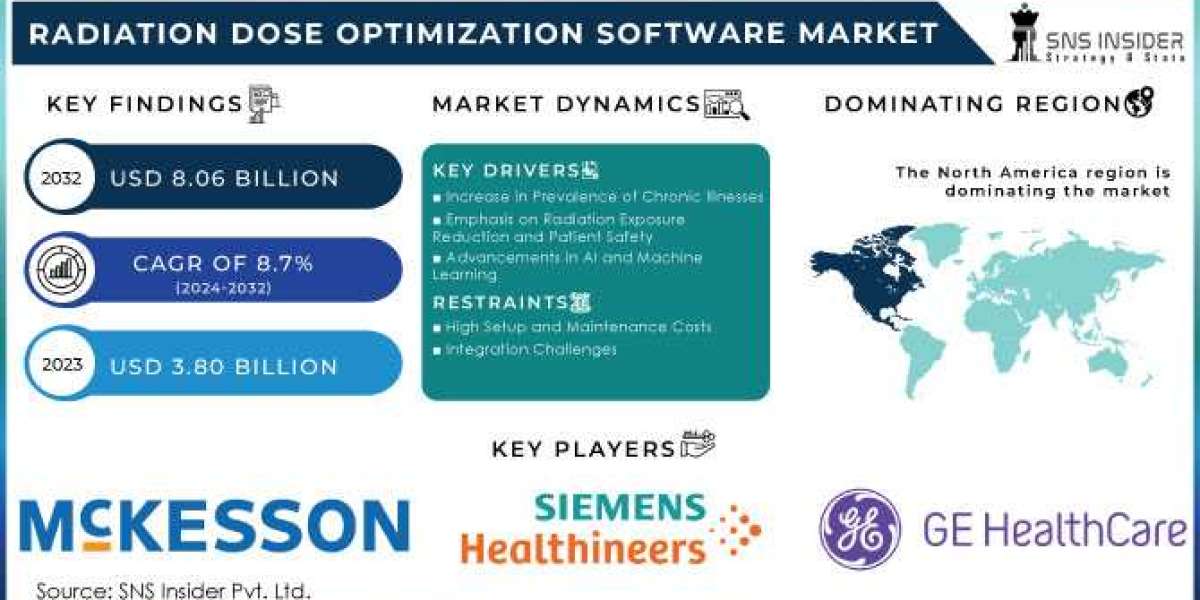The Radiation Dose Optimization Software Market is witnessing significant growth as healthcare institutions worldwide emphasize the reduction of radiation exposure while maintaining diagnostic accuracy. These software solutions assist medical professionals in optimizing radiation doses for imaging procedures, ensuring patient safety without compromising the quality of medical imaging. As the use of imaging technologies such as CT scans, X-rays, and MRI increases globally, the need for efficient dose optimization is more important than ever.
The Radiation Dose Optimization Software Market was valued at USD 3.80 Billion in 2023 and will reach USD 8.06 Billion by 2032, with a growing CAGR of 8.7% during the forecast period of 2024-2032.
Regional Analysis
The Radiation Dose Optimization Software Market exhibits diverse growth patterns across various regions. North America, led by the U.S. and Canada, dominates the market due to the high adoption of advanced healthcare technologies and a strong emphasis on patient safety. The region also benefits from robust healthcare infrastructure and government regulations promoting safe radiation use. Europe is another key market, particularly in countries like Germany, France, and the U.K., where hospitals are rapidly integrating radiation dose optimization software. In Asia-Pacific, the market is growing at an impressive rate, fueled by increasing healthcare investments in countries like China, India, and Japan. These regions are also experiencing significant improvements in diagnostic imaging technology, driving demand for software solutions. The Middle East and Africa show steady growth as healthcare facilities upgrade their radiology departments, while Latin America’s market is evolving with increasing awareness and investments in health technology.
Get Free Sample Report@ https://www.snsinsider.com/sample-request/4503
Key Points:
- Increasing demand for radiation dose optimization due to growing healthcare awareness.
- Rising implementation of AI and machine learning in software solutions.
- Stringent regulations on radiation safety driving the adoption of optimization tools.
- Key players include companies such as Siemens Healthineers, GE Healthcare, and Philips Healthcare.
- High growth in emerging markets like Asia-Pacific and Latin America.
- Adoption rates of software solutions are influenced by healthcare infrastructure and budget allocations.
- Government initiatives and guidelines ensuring safe radiation practices boost the market growth.
- Software solutions are increasingly integrated with cloud platforms for better scalability and data management.
Key Players
- GE Healthcare
- Siemens Healthineers
- Philips Healthcare
- Canon Medical Systems
- Fujifilm (FUJIFILM Corporation)
- McKesson Corporation
- IMAGO Radiology
- Sectra AB
- Merge Healthcare (an IBM Company)
- Toshiba Medical Systems and others
Future Scope
The future of the Radiation Dose Optimization Software Market looks promising, with continuous advancements in imaging technologies and software capabilities. As healthcare providers adopt more sophisticated diagnostic imaging tools, the demand for intelligent and automated radiation dose management systems is expected to grow. Integration with artificial intelligence (AI) and machine learning algorithms will enhance real-time dose optimization, offering a more personalized approach to patient safety. Additionally, the increasing focus on remote healthcare solutions and cloud-based software platforms will broaden the reach of radiation dose optimization tools, allowing healthcare institutions to improve their operations and ensure patient safety across geographies. As the market matures, there will be increased collaboration between healthcare institutions, software developers, and regulatory bodies, contributing to the development of standardized practices and more accessible software solutions for all types of healthcare facilities.
Conclusion
The Radiation Dose Optimization Software Market is positioned for continued expansion as the healthcare industry places greater emphasis on patient safety, regulatory compliance, and the integration of technology into medical imaging practices. With the potential for further innovations in AI and cloud-based platforms, the market will continue to offer significant growth opportunities for both established companies and emerging players. By optimizing radiation doses effectively, this software not only reduces healthcare risks but also improves diagnostic accuracy, thus fostering a safer and more efficient healthcare environment. The market’s future is optimistic, driven by technological advancements, growing awareness, and increasing demand for safer healthcare solutions worldwide.
Contact Us:
Jagney Dave - Vice President of Client Engagement
Phone: +1-315 636 4242 (US) | +44- 20 3290 5010 (UK)














